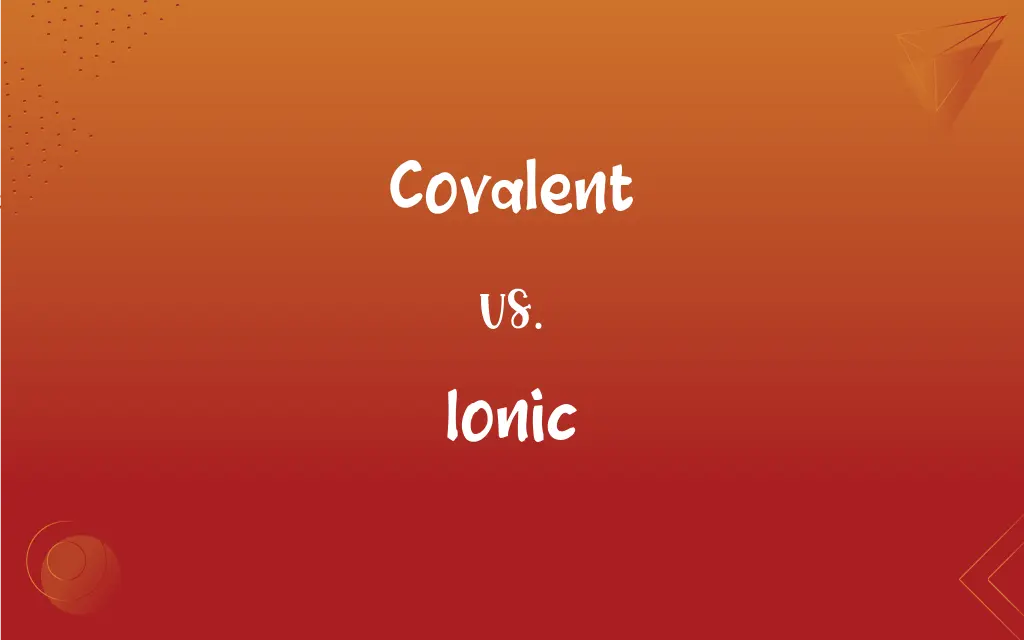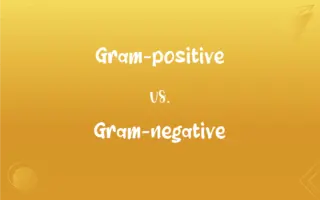Covalent vs. Ionic: What's the Difference?
Edited by Aimie Carlson || By Harlon Moss || Updated on October 26, 2023
Covalent bonds involve the sharing of electrons; ionic bonds result from the transfer of electrons.

Key Differences
Covalent bonds are characterized by atoms sharing electrons to achieve stability, usually between two non-metals. On the contrary, ionic bonds are formed when one atom donates an electron to another atom, typically between a metal and a non-metal.
In a covalent bond, the bonded atoms have a shared electron pair, creating a strong link between them. In ionic bonding, the atom that loses an electron becomes a positive ion (cation), and the one that gains an electron becomes a negative ion (anion).
Covalent compounds often have lower melting and boiling points compared to ionic compounds. This is because covalent compounds consist of individual molecules, while ionic compounds form a lattice structure with strong electrostatic forces.
Due to their lattice structure, ionic compounds generally conduct electricity when dissolved in water or melted. Covalent compounds, however, often don't conduct electricity as they don't have free-moving charged particles.
Covalent compounds can be formed in various shapes based on the number of shared electron pairs. Ionic compounds, in contrast, usually organize in a regular repeating pattern due to the attraction between oppositely charged ions.
ADVERTISEMENT
Comparison Chart
Formation Mechanism
Involves sharing of electrons.
Involves transfer of electrons.
Commonly Found Between
Non-metals.
Metal and non-metal.
Conductivity
Generally non-conductive.
Conductive when molten or in solution.
Melting and Boiling Points
Typically lower.
Typically higher.
Structural Form
Individual molecules with various shapes.
Lattice structure with repeating pattern.
ADVERTISEMENT
Covalent and Ionic Definitions
Covalent
Pertaining to molecules formed by covalent bonds.
Methane is a covalent compound formed by carbon and hydrogen.
Ionic
Characterized by the formation or presence of ions.
In an ionic compound, cations and anions are held together by electrostatic forces.
Covalent
A bond formed by the sharing of electrons between atoms.
Water (H₂O) has a covalent bond between hydrogen and oxygen atoms.
Ionic
Relating to ions or the phenomenon of ionization.
Salt dissolved in water undergoes ionic dissociation.
Covalent
Denoting elements or compounds exhibiting covalent bonding.
Organic compounds primarily exhibit covalent characteristics.
Ionic
A bond formed through the electrostatic attraction between oppositely charged ions.
Sodium chloride (NaCl) forms an ionic bond between sodium and chlorine.
Covalent
Of or relating to a bond where atoms share electron pairs.
The covalent nature of the bond gives stability to the molecule.
Ionic
Denoting compounds or bonds formed by the transfer of electrons.
Calcium oxide (CaO) exhibits an ionic bond with the transfer of electrons.
Covalent
Characterized by electron sharing between two non-metallic elements.
The bond in chlorine gas (Cl₂) is covalent as both atoms share electrons.
Ionic
Of or relating to a bond where atoms transfer electrons, resulting in charged ions.
The strong ionic attraction gives the compound high melting and boiling points.
Covalent
The number of electron pairs an atom can share with other atoms.
Ionic
Of or relating to Ionia or the Ionians.
Covalent
(chemistry) Containing or characterized by a covalent bond.
Covalent
Of or relating to or characterized by covalence;
Covalent bond
FAQs
Why don't covalent compounds conduct electricity?
They usually lack free-moving charged particles essential for conduction.
What's the main difference between covalent and ionic bonds?
Covalent bonds involve electron sharing; ionic bonds involve electron transfer.
Are covalent bonds stronger than ionic ones?
It depends on the specific compounds; some covalent bonds can be very strong, while others might be weaker than certain ionic bonds.
What determines the shape of a covalent molecule?
The number of shared electron pairs and electron repulsions determine the shape.
Can covalent compounds be solid?
Yes, many organic compounds with covalent bonds are solid at room temperature.
Can covalent bonds occur between the same elements?
Yes, like in oxygen (O₂) or nitrogen (N₂) where the same atoms share electrons.
How do metallic bonds differ from ionic and covalent?
Metallic bonds involve a "sea" of delocalized electrons, unlike the specific electron transfers or sharings of ionic and covalent bonds.
How are coordinate covalent bonds different?
Both electrons in the bond come from the same atom, unlike regular covalent bonds.
Can a compound have both covalent and ionic bonds?
Yes, compounds like ammonium chloride exhibit both bonding types.
Are all covalent bonds single?
No, there can be single, double, or even triple covalent bonds.
What is a polar covalent bond?
It's a covalent bond where electrons are shared unequally, resulting in a charge difference.
What happens to ionic compounds in an aqueous solution?
They usually dissociate into individual ions, allowing the solution to conduct electricity.
Do ionic compounds dissolve easily in water?
Many do because water can disrupt the electrostatic forces in the ionic lattice.
Do covalent bonds always involve two atoms?
While most covalent bonds involve two atoms, there are exceptions like coordinate covalent bonds.
Can ionic compounds be liquid?
Typically not at room temperature, but when melted, they can become liquid.
Why are ionic compounds generally more brittle?
The strong electrostatic forces in ionic lattices can lead to brittleness when disrupted.
Why are ionic compounds typically solid at room temperature?
The strong attractions between ions result in a solid lattice structure.
Can covalent compounds be liquids or gases?
Yes, due to weaker intermolecular forces compared to ionic compounds.
What gives ionic compounds high melting points?
The strong electrostatic forces between oppositely charged ions.
Is it possible for ionic bonds to occur between two non-metals?
Rarely, as non-metals typically share, not transfer, electrons.
About Author
Written by
Harlon MossHarlon is a seasoned quality moderator and accomplished content writer for Difference Wiki. An alumnus of the prestigious University of California, he earned his degree in Computer Science. Leveraging his academic background, Harlon brings a meticulous and informed perspective to his work, ensuring content accuracy and excellence.
Edited by
Aimie CarlsonAimie Carlson, holding a master's degree in English literature, is a fervent English language enthusiast. She lends her writing talents to Difference Wiki, a prominent website that specializes in comparisons, offering readers insightful analyses that both captivate and inform.































































